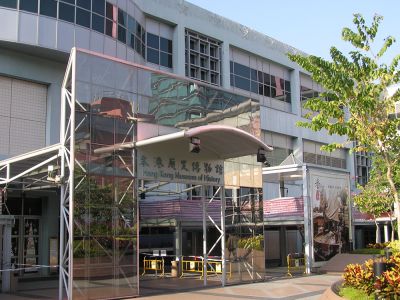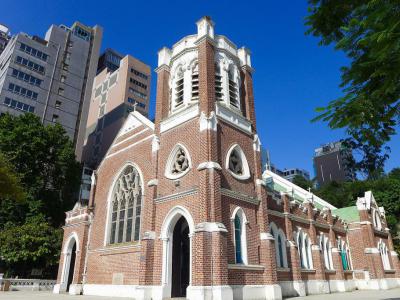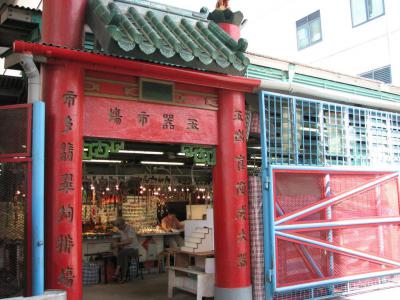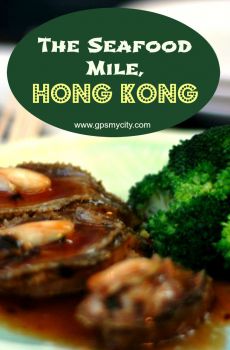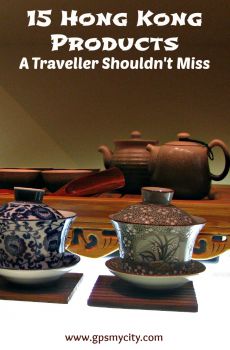
Kowloon Walking Tour (Self Guided), Hong Kong
The most popular part of Hong Kong outside the Downtown area, the Kowloon district is also one of the most densely populated neighborhoods on the planet, packed to the brim with all sorts of shops and restaurants. Situated north of the Hong Kong island, Kowloon can be described as the mirror of Central Hong Kong.
Some of the top attractions in Kowloon are set around the dazzling Nathan Road (a bustling thoroughfare lined with an array of retail and dining options), and the scenic Tsim Sha Tsui Promenade. The latter, in particular, offers stunning views of Hong Kong's iconic skyline and Victoria Harbour.
Along this promenade, you can find the Avenue of Stars, which pays tribute to the city's film industry and its stars (notably, Bruce Lee). Also, don't miss the Clock Tower not far off, which is a historical landmark that adds a great deal of charm to the waterfront.
One of the prominent cultural destinations in the area is the Hong Kong Museum of History, where you can delve into Hong Kong's yesteryear.
The Former Marine Police Headquarters is a captivating colonial-era building that today houses a hotel and shopping complex, while The Peninsula Hotel is a luxurious establishment known for its elegance and afternoon tea.
Saint Andrew Church on Nathan Road is an architectural gem that stands in contrast to its more modern surroundings as a testament to the city's diverse religious heritage and colonial past.
For those interested in jade jewelry and other trinkets, the Jade Market is a genuine treasure trove, offering a glimpse into Chinese culture.
History buffs, shoppers, and foodies of all stripes flock to Kowloon regularly to satisfy their cravings. Indeed, this vibrant part of Hong Kong has something for everyone. So, take this self-guided walk, and don't miss out on the chance to create lasting memories in Kowloon!
Some of the top attractions in Kowloon are set around the dazzling Nathan Road (a bustling thoroughfare lined with an array of retail and dining options), and the scenic Tsim Sha Tsui Promenade. The latter, in particular, offers stunning views of Hong Kong's iconic skyline and Victoria Harbour.
Along this promenade, you can find the Avenue of Stars, which pays tribute to the city's film industry and its stars (notably, Bruce Lee). Also, don't miss the Clock Tower not far off, which is a historical landmark that adds a great deal of charm to the waterfront.
One of the prominent cultural destinations in the area is the Hong Kong Museum of History, where you can delve into Hong Kong's yesteryear.
The Former Marine Police Headquarters is a captivating colonial-era building that today houses a hotel and shopping complex, while The Peninsula Hotel is a luxurious establishment known for its elegance and afternoon tea.
Saint Andrew Church on Nathan Road is an architectural gem that stands in contrast to its more modern surroundings as a testament to the city's diverse religious heritage and colonial past.
For those interested in jade jewelry and other trinkets, the Jade Market is a genuine treasure trove, offering a glimpse into Chinese culture.
History buffs, shoppers, and foodies of all stripes flock to Kowloon regularly to satisfy their cravings. Indeed, this vibrant part of Hong Kong has something for everyone. So, take this self-guided walk, and don't miss out on the chance to create lasting memories in Kowloon!
How it works: Download the app "GPSmyCity: Walks in 1K+ Cities" from Apple App Store or Google Play Store to your mobile phone or tablet. The app turns your mobile device into a personal tour guide and its built-in GPS navigation functions guide you from one tour stop to next. The app works offline, so no data plan is needed when traveling abroad.
Kowloon Walking Tour Map
Guide Name: Kowloon Walking Tour
Guide Location: Hong Kong » Hong Kong (See other walking tours in Hong Kong)
Guide Type: Self-guided Walking Tour (Sightseeing)
# of Attractions: 9
Tour Duration: 2 Hour(s)
Travel Distance: 4.6 Km or 2.9 Miles
Author: emma
Sight(s) Featured in This Guide:
Guide Location: Hong Kong » Hong Kong (See other walking tours in Hong Kong)
Guide Type: Self-guided Walking Tour (Sightseeing)
# of Attractions: 9
Tour Duration: 2 Hour(s)
Travel Distance: 4.6 Km or 2.9 Miles
Author: emma
Sight(s) Featured in This Guide:
- Hong Kong Museum of History
- Tsim Sha Tsui Promenade
- Avenue of Stars
- Clock Tower
- Former Marine Police Headquarters
- The Peninsula Hotel
- Nathan Road
- St. Andrew Church
- Jade Market
1) Hong Kong Museum of History (must see)
The Hong Kong Museum of History focuses on the development of the city. The permanent exhibit is called The Hong Kong Story, which has more than 4,000 exhibits in eight galleries. It uses prehistoric fossils, ancient pottery and colonial documents to share the story.
The roots of the Hong Kong Museum of History begin with the City Museum and Art Gallery, which was established in 1962. Seven years later, in 1975, the museum was split into two entities: the Hong Kong Museum of History and the Hong Kong Museum of Art. The museum occupied two temporary spots before moving to its present location in 1998.
Visitors who wish to see the Hong Kong Museum of History can explore the galleries daily beginning at 10 AM. The museum remains open through 6 PM Mondays and Wednesdays through Thursdays. It is open until 7 PM on Saturdays and Sundays. The museum is closed on Tuesdays.
Why You Should Visit:
A multi-level, multimedia tour of Hong Kong through the centuries. Life-sized exhibits, walkthrough areas and lifelike monuments abound.
Tip:
Go on a Wednesday so you can get in for free – but just know there will be lots of school kids. Unless you're a geology fan, breeze through the first sections about geological history and get to the cultural rooms.
The roots of the Hong Kong Museum of History begin with the City Museum and Art Gallery, which was established in 1962. Seven years later, in 1975, the museum was split into two entities: the Hong Kong Museum of History and the Hong Kong Museum of Art. The museum occupied two temporary spots before moving to its present location in 1998.
Visitors who wish to see the Hong Kong Museum of History can explore the galleries daily beginning at 10 AM. The museum remains open through 6 PM Mondays and Wednesdays through Thursdays. It is open until 7 PM on Saturdays and Sundays. The museum is closed on Tuesdays.
Why You Should Visit:
A multi-level, multimedia tour of Hong Kong through the centuries. Life-sized exhibits, walkthrough areas and lifelike monuments abound.
Tip:
Go on a Wednesday so you can get in for free – but just know there will be lots of school kids. Unless you're a geology fan, breeze through the first sections about geological history and get to the cultural rooms.
2) Tsim Sha Tsui Promenade (must see)
Tsim Sha Tsui, or TST as it is often called, is a neighborhood in southern Hong Kong. TST is a popular tourist area thanks to the large number of shops, restaurants and museums. One of the favorite spots in TST is the Tsim Sha Tsui Promenade.
The promenade is a 1.6 kilometers stretch that shows tourists views of the Hong Kong skyline and Victoria Bay. Many of Hong Kong's top tourist spots are near the promenade. These include the Tsim Sha Tsui Clock Tower, the Avenue of Stars, the Hong Kong Cultural Center, the Hong Kong Space Museum and the Hong Kong Museum of Art.
A daytime visit to the promenade is necessary to see and do as much as possible. However, visitors should plan another trip to the Tsim Sha Tsui Promenade at night. This is when the Symphony of the Stars music and light show takes place. Watching the Hong Kong skyline illuminated from the Promenade is a sight that must not be missed.
The promenade is a 1.6 kilometers stretch that shows tourists views of the Hong Kong skyline and Victoria Bay. Many of Hong Kong's top tourist spots are near the promenade. These include the Tsim Sha Tsui Clock Tower, the Avenue of Stars, the Hong Kong Cultural Center, the Hong Kong Space Museum and the Hong Kong Museum of Art.
A daytime visit to the promenade is necessary to see and do as much as possible. However, visitors should plan another trip to the Tsim Sha Tsui Promenade at night. This is when the Symphony of the Stars music and light show takes place. Watching the Hong Kong skyline illuminated from the Promenade is a sight that must not be missed.
3) Avenue of Stars
The Avenue of the Stars is Hong Kong's celebration of celebrities who are from or have lived in Hong Kong. It is located at the southern end of the Tsim Sha Tsui Promenade along the Victoria Bay waterfront.
The waterfront walk is teeming with people who enjoy the easy walk along the bay. It also offers many benches for resting, people watching and enjoying the view. The avenue includes a replica of the Hong Kong Film Awards statue, a bronze statue of Bruce Lee and a replica of the 2008 Summer Olympics torch.
Celebrities honored along the Avenue of the Stars include actors, producers, directors, scriptwriters, opera stars and comedians. Also included are some theatre owners, publicity officers and even a cartoon character.
All of those honored have found fame throughout China, though some have reached world-wide notoriety. Those include such famous names as Jackie Chan, Bruce Lee, John Woo, Chow Yun-Fat and Jet Li.
The waterfront walk is teeming with people who enjoy the easy walk along the bay. It also offers many benches for resting, people watching and enjoying the view. The avenue includes a replica of the Hong Kong Film Awards statue, a bronze statue of Bruce Lee and a replica of the 2008 Summer Olympics torch.
Celebrities honored along the Avenue of the Stars include actors, producers, directors, scriptwriters, opera stars and comedians. Also included are some theatre owners, publicity officers and even a cartoon character.
All of those honored have found fame throughout China, though some have reached world-wide notoriety. Those include such famous names as Jackie Chan, Bruce Lee, John Woo, Chow Yun-Fat and Jet Li.
4) Clock Tower
The Clock Tower is a 44 meter, or 144 foot, tower in Tsim Sha Tsui. Formerly known as the Kowloon-Canton Railway Clock Tower, it is the only remaining relic of the aforementioned railway. The tower is a well-known landmark near the Tsim Sha Tsui Promenade and the Avenue of the Stars.
Construction of the tower was completed in 1915. The first clock face was repurposed from the Pedder Street Clock Tower, which was demolished in 1913. The remaining three clock faces were not added until 1920.
The Clock Tower remains as a monument under the Antiquities and Monuments Ordinance. However, it was originally slated to be demolished when the Kowloon-Canton Railway was moved to Hung Hom Bay. The Heritage Society of Hong Kong battled to keep the station from being torn down, but compromised with the city to keep the tower intact while the rest of the structure was removed.
Visitors can view the Clock Tower from its perch between the Kowloon Public Pier and the Hong Kong Cultural Centre. Tourists may be able to enter the tower depending on maintenance schedules.
The tower has been listed as a declared monument in Hong Kong since 1990.
Construction of the tower was completed in 1915. The first clock face was repurposed from the Pedder Street Clock Tower, which was demolished in 1913. The remaining three clock faces were not added until 1920.
The Clock Tower remains as a monument under the Antiquities and Monuments Ordinance. However, it was originally slated to be demolished when the Kowloon-Canton Railway was moved to Hung Hom Bay. The Heritage Society of Hong Kong battled to keep the station from being torn down, but compromised with the city to keep the tower intact while the rest of the structure was removed.
Visitors can view the Clock Tower from its perch between the Kowloon Public Pier and the Hong Kong Cultural Centre. Tourists may be able to enter the tower depending on maintenance schedules.
The tower has been listed as a declared monument in Hong Kong since 1990.
5) Former Marine Police Headquarters
The Former Marine Police Headquarters is a compound that dates to 1884. It was the headquarters of the water police from the time that it was built through 1996. Once it was no longer needed for this purpose, the compound was adapted into a cultural center. It is now collectively known as 1881 Heritage.
The compound consists of five distinct buildings. The Main Building, now known as Hullett House, was a two-story structure that was used as residences for married officers and the superintendent. It is now a boutique hotel.
Other buildings that were part of the compound include the stable house, signal tower, Old Kowloon fire station and the fire station accommodation block.
Along with the newly formed hotels and suites, 1881 Heritage now features luxury retail shops from names like Van Cleef & Arpels, Mont Blanc and Mikimoto. Restaurants on the site offer fine dining in local and French cuisines.
The compound consists of five distinct buildings. The Main Building, now known as Hullett House, was a two-story structure that was used as residences for married officers and the superintendent. It is now a boutique hotel.
Other buildings that were part of the compound include the stable house, signal tower, Old Kowloon fire station and the fire station accommodation block.
Along with the newly formed hotels and suites, 1881 Heritage now features luxury retail shops from names like Van Cleef & Arpels, Mont Blanc and Mikimoto. Restaurants on the site offer fine dining in local and French cuisines.
6) The Peninsula Hotel
The Peninsula Hotel is one of Hong Kong's older luxury hotels. It was completed in 1928 with the goal of being the most luxuriant hotel in the East.
The hotel was founded by the Kadoorie family who hosted nightly dinners, dinner dances and afternoon tea dances. It also held concerts every Sunday. It quickly became a celebrity favorite and a popular meeting place.
Perhaps most notably, the Peninsula Hotel's third floor was the spot where the governor of Hong Kong, Mark Aitchison Young, surrendered to Japanese forces at the culmination of the Battle of Hong Kong. The hotel was briefly renamed the Toa Hotel as Japanese officers turned the building into their headquarters.
The hotel has been expanded and refurbished in recent years. One of the most widely recognized additions to the Peninsula Hotel is its fleet of green Rolls Royces. It is also known for its fashion houses, which are home to some of the biggest names in the industry. These include Gucci, Prada, Cartier, Hermes and Harry Winston.
Visitors can find the Peninsula Hotel on Salisbury Road, adjacent to the Hong Kong Space Museum.
The hotel was founded by the Kadoorie family who hosted nightly dinners, dinner dances and afternoon tea dances. It also held concerts every Sunday. It quickly became a celebrity favorite and a popular meeting place.
Perhaps most notably, the Peninsula Hotel's third floor was the spot where the governor of Hong Kong, Mark Aitchison Young, surrendered to Japanese forces at the culmination of the Battle of Hong Kong. The hotel was briefly renamed the Toa Hotel as Japanese officers turned the building into their headquarters.
The hotel has been expanded and refurbished in recent years. One of the most widely recognized additions to the Peninsula Hotel is its fleet of green Rolls Royces. It is also known for its fashion houses, which are home to some of the biggest names in the industry. These include Gucci, Prada, Cartier, Hermes and Harry Winston.
Visitors can find the Peninsula Hotel on Salisbury Road, adjacent to the Hong Kong Space Museum.
7) Nathan Road
It is nearly impossible to visit Hong Kong without walking along Nathan Road. This road, often referred to as the Golden Mile, is a north-south running street that is populated with favorite tourist destinations.
Nathan Road meets with Salisbury Road at the Hong Kong Space Museum and The Peninsula Hotel. Traveling north along Nathan Road, tourists will find Kung Fu Court, the Maze Garden at Kowloon Park and Saint Andrew's Church.
The origins of Nathan Road date to 1861 when the first section of the road was built by British colonizers. It was named Nathan Road in honor of the lieutenant governor Sir Matthew Nathan.
Tourists will find a number of shopping areas and restaurants along Nathan Road. Though the road is highly trafficked, the sidewalks are wide enough to offer ample space on both sides. Those who are touring the street should schedule plenty of time for stopping in shops and enjoying the atmosphere.
Nathan Road meets with Salisbury Road at the Hong Kong Space Museum and The Peninsula Hotel. Traveling north along Nathan Road, tourists will find Kung Fu Court, the Maze Garden at Kowloon Park and Saint Andrew's Church.
The origins of Nathan Road date to 1861 when the first section of the road was built by British colonizers. It was named Nathan Road in honor of the lieutenant governor Sir Matthew Nathan.
Tourists will find a number of shopping areas and restaurants along Nathan Road. Though the road is highly trafficked, the sidewalks are wide enough to offer ample space on both sides. Those who are touring the street should schedule plenty of time for stopping in shops and enjoying the atmosphere.
8) St. Andrew Church
Saint Andrew's Church is located on Nathan Road, in Kowloon Hong Kong. It is an Anglican church of the Sheng Kung Hui Province of Hong Kong. The Church of Saint Andrew’s is in the Diocese of Western Kowloon. The church offers services in both English and Putonghua and it is the oldest Protestant church present in the region.
In 1904, Sir Catchick Paul Chater, a prominent British-Indian businessman of Armenian descent, offered thirty five thousand dollars to finance the construction of an Anglican church in Kowloon. The site chosen for the church was near a large garden, located in an area between Robinson Road, (which has now been renamed Nathan Road) and Austin Road. The construction of the church began in 1904 and was completed in 1906.
The church architecture is of the Early English Gothic style, with the main edifice built of granite and red brick. The Victorian-Gothic style building is cruciform in plan and has a single bell tower, shaped like a cross, in front of it.
During the Japanese occupation of Hong Kong in World War II, the church was used as a Shinto shrine, but apart from this period, it has continuously been used for Christian worship. Saint Andrew’s Christian Center was also built next to the church in1979. The Center houses different Christian organizations.
In 1904, Sir Catchick Paul Chater, a prominent British-Indian businessman of Armenian descent, offered thirty five thousand dollars to finance the construction of an Anglican church in Kowloon. The site chosen for the church was near a large garden, located in an area between Robinson Road, (which has now been renamed Nathan Road) and Austin Road. The construction of the church began in 1904 and was completed in 1906.
The church architecture is of the Early English Gothic style, with the main edifice built of granite and red brick. The Victorian-Gothic style building is cruciform in plan and has a single bell tower, shaped like a cross, in front of it.
During the Japanese occupation of Hong Kong in World War II, the church was used as a Shinto shrine, but apart from this period, it has continuously been used for Christian worship. Saint Andrew’s Christian Center was also built next to the church in1979. The Center houses different Christian organizations.
9) Jade Market
The Jade Market is an indoor market that sells precious and semi-precious gemstones, pearl and jade. It is known for offering souvenirs of all types and price ranges to shoppers. It is also popular because it offers the open-air street market experience in an indoor environment.
The market has over 400 shops and stalls with items to fit all shopper's budgets. All wares are up for bartering. Prices can start at HK$15 and rise to however much vendors think they can get from the buyer. Always haggle at half the price or less to come to an agreeable compromise.
Top quality jade is pure green and very expensive. Most pieces can have a yellow tinge but the finished item should be devoid of brown or grey. The best jade is semi-transparent, while opaque jade with cloudy patches tends to be of less value. The Chinese word for jade translates to beauty and purity. The stone symbolizes long life and good health, as such, many traditionalists wear jade to guard against ill health.
The Jade Market is open from 10 AM to 4 PM daily. Wise tourists should plan to visit the market as early as possible because that is often when the best deals are to be made.
The market has over 400 shops and stalls with items to fit all shopper's budgets. All wares are up for bartering. Prices can start at HK$15 and rise to however much vendors think they can get from the buyer. Always haggle at half the price or less to come to an agreeable compromise.
Top quality jade is pure green and very expensive. Most pieces can have a yellow tinge but the finished item should be devoid of brown or grey. The best jade is semi-transparent, while opaque jade with cloudy patches tends to be of less value. The Chinese word for jade translates to beauty and purity. The stone symbolizes long life and good health, as such, many traditionalists wear jade to guard against ill health.
The Jade Market is open from 10 AM to 4 PM daily. Wise tourists should plan to visit the market as early as possible because that is often when the best deals are to be made.
Walking Tours in Hong Kong, Hong Kong
Create Your Own Walk in Hong Kong
Creating your own self-guided walk in Hong Kong is easy and fun. Choose the city attractions that you want to see and a walk route map will be created just for you. You can even set your hotel as the start point of the walk.
Colonial Buildings in Central Hong Kong
Having been a British colony for over a century, Hong Kong boasts a wealth of colonial architecture. The majority of old buildings, some designated national heritage objects, are concentrated in the Central part of the city.
The Flagstaff House Museum of Tea Ware is one such charming colonial edifice that once served as the residence of the Commander of the British forces. Today, it houses a... view more
Tour Duration: 2 Hour(s)
Travel Distance: 2.5 Km or 1.6 Miles
The Flagstaff House Museum of Tea Ware is one such charming colonial edifice that once served as the residence of the Commander of the British forces. Today, it houses a... view more
Tour Duration: 2 Hour(s)
Travel Distance: 2.5 Km or 1.6 Miles
Downtown Introduction Walking Tour
Hong Kong has a long, storied history, that stretches back centuries. However, much of what we associate with today's Hong Kong is more recent in nature.
At the end of the First Opium War, in 1842, the Qing Dynasty ceded control of the region to the British who colonized and westernized it, creating businesses and building roads, schools, and churches. Throughout 155 years of British rule,... view more
Tour Duration: 2 Hour(s)
Travel Distance: 3.7 Km or 2.3 Miles
At the end of the First Opium War, in 1842, the Qing Dynasty ceded control of the region to the British who colonized and westernized it, creating businesses and building roads, schools, and churches. Throughout 155 years of British rule,... view more
Tour Duration: 2 Hour(s)
Travel Distance: 3.7 Km or 2.3 Miles
Causeway Bay Walking Tour
If you're looking for a taste of Hong Kong's energetic urban life, Causeway Bay is the place to be. Well known for its mega shopping malls and skyscrapers “rubbing shoulders” with rustic streets and picturesque corners, this bustling district is one of the city's most popular shopping and entertainment hubs.
The foremost among its landmarks is Times Square. Despite the name,... view more
Tour Duration: 1 Hour(s)
Travel Distance: 2.8 Km or 1.7 Miles
The foremost among its landmarks is Times Square. Despite the name,... view more
Tour Duration: 1 Hour(s)
Travel Distance: 2.8 Km or 1.7 Miles
Useful Travel Guides for Planning Your Trip
The Seafood Mile, Hong Kong
Cheung Chau is one of a cluster of Islands off the coast of Hong Kong. It has a fishing harbor to the front, which is lit up at night with tiny green, blue and white boat lights. The harbor is overlooked by many restaurants and street food can be bought from many vendors, who line up throwing an...
15 Hong Kong Products A Traveller Shouldn't Miss
The image of Hong Kong has been much popular with tourists since the late 1960s-early 70s, in large part due to the Bruce Lee movies, and has remained so after the city was ceded back to China in 1997. Still, despite such popularity, there're quite a few things, originally made in Hong Kong,...
The Most Popular Cities
/ view all
